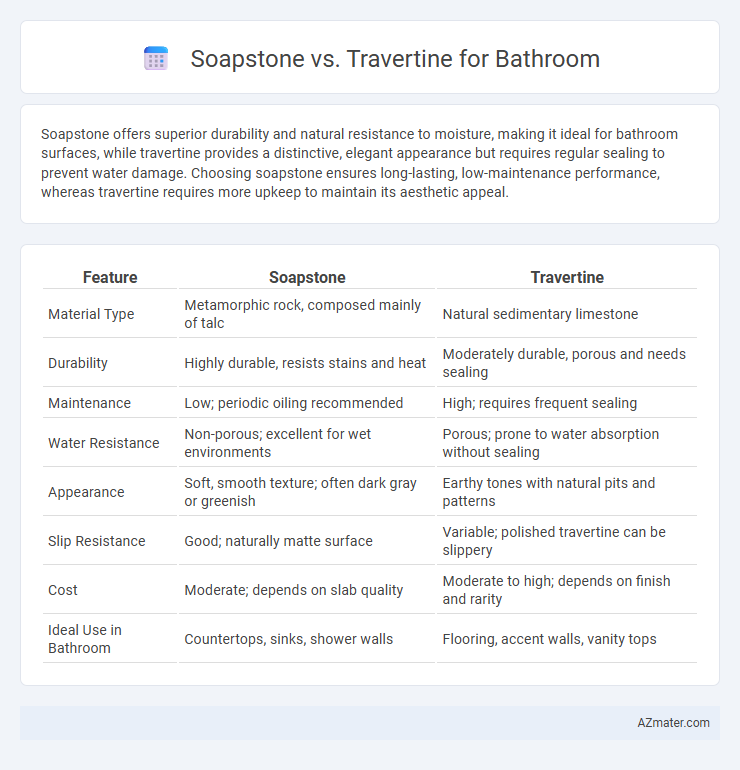Soapstone offers superior durability and natural resistance to moisture, making it ideal for bathroom surfaces, while travertine provides a distinctive, elegant appearance but requires regular sealing to prevent water damage. Choosing soapstone ensures long-lasting, low-maintenance performance, whereas travertine requires more upkeep to maintain its aesthetic appeal.
Table of Comparison
| Feature | Soapstone | Travertine |
|---|---|---|
| Material Type | Metamorphic rock, composed mainly of talc | Natural sedimentary limestone |
| Durability | Highly durable, resists stains and heat | Moderately durable, porous and needs sealing |
| Maintenance | Low; periodic oiling recommended | High; requires frequent sealing |
| Water Resistance | Non-porous; excellent for wet environments | Porous; prone to water absorption without sealing |
| Appearance | Soft, smooth texture; often dark gray or greenish | Earthy tones with natural pits and patterns |
| Slip Resistance | Good; naturally matte surface | Variable; polished travertine can be slippery |
| Cost | Moderate; depends on slab quality | Moderate to high; depends on finish and rarity |
| Ideal Use in Bathroom | Countertops, sinks, shower walls | Flooring, accent walls, vanity tops |
Introduction to Soapstone and Travertine
Soapstone and travertine are popular natural stones commonly used in bathroom design for their durability and aesthetic appeal. Soapstone is a dense, non-porous metamorphic rock composed primarily of talc, offering excellent resistance to moisture, heat, and stains, making it ideal for bathroom countertops and sinks. Travertine, a form of limestone characterized by its porous texture and warm, earthy tones, requires sealing to protect against water absorption but provides a classic, elegant look for bathroom floors and walls.
Visual Appeal and Aesthetic Differences
Soapstone offers a smooth, matte finish with rich, natural veining that darkens over time, creating a warm and inviting bathroom atmosphere. Travertine showcases a porous, textured surface with natural pits and a range of earthy tones, providing a classic, rustic elegance. The choice between soapstone's subtle, consistent appearance and travertine's variegated pattern impacts the overall bathroom aesthetic, influencing style from modern minimalist to traditional warmth.
Durability and Longevity
Soapstone offers exceptional durability and resists staining and heat, making it ideal for bathroom countertops and sinks that face frequent water exposure. Travertine, while visually appealing with its natural veining, is more porous and susceptible to scratches and etching, requiring regular sealing to maintain its longevity in humid bathroom environments. Choosing soapstone ensures a long-lasting surface with minimal maintenance compared to the higher upkeep demands of travertine.
Water and Stain Resistance
Soapstone offers superior water resistance due to its non-porous structure, making it less prone to water absorption and staining, ideal for bathroom environments. Travertine, being a porous natural stone, requires regular sealing to prevent water damage and staining, which can compromise its durability over time. For long-term maintenance and lasting aesthetic appeal in bathrooms, soapstone provides a more resilient surface against moisture and common bathroom stains.
Maintenance Requirements
Soapstone requires minimal maintenance in bathrooms due to its non-porous nature and resistance to stains, needing only occasional oiling to maintain its rich appearance. Travertine, being a porous natural stone, demands regular sealing to prevent water absorption and staining, along with gentle cleaning to avoid etching and damage. For durable, low-maintenance bathroom surfaces, soapstone offers a more user-friendly option compared to the higher upkeep demands of travertine.
Cost Comparison
Soapstone typically costs between $70 and $120 per square foot, including installation, making it a mid-range option for bathroom countertops. Travertine, priced from $50 to $100 per square foot installed, often offers a more affordable choice but may require additional sealing and maintenance costs over time. Comparing total expenses, soapstone's durability can reduce long-term costs despite a higher initial price, while travertine presents lower upfront fees with potential ongoing upkeep investments.
Installation Considerations
Soapstone offers easier installation in bathrooms due to its softer nature and ability to be cut with standard woodworking tools, reducing labor time and costs compared to travertine. Travertine requires specialized cutting equipment because of its hardness and porous texture, demanding precise sealing to prevent moisture absorption in bathroom environments. Proper substrate preparation and moisture barriers are critical for both materials to ensure long-term durability and resistance to mold and water damage.
Comfort and Feel Underfoot
Soapstone provides a warm, smooth surface that remains comfortable underfoot even in cooler bathroom environments, offering a natural, slightly cushioned feel. Travertine tends to feel cooler and harder, with a more textured surface that can add slip resistance but may feel less comfortable for prolonged standing. The choice between soapstone's soft warmth and travertine's solid durability impacts the overall bathroom comfort and tactile experience.
Environmental Impact and Sustainability
Soapstone is a naturally occurring metamorphic rock known for its durability, low porosity, and minimal chemical treatments, making it an eco-friendly choice for bathroom surfaces with a reduced environmental footprint. Travertine, a form of limestone deposited by mineral springs, often requires more intensive quarrying and processing, which can lead to higher environmental impact and less sustainable sourcing practices. Choosing soapstone supports sustainable design through its longevity, ease of maintenance without harsh chemicals, and lower resource consumption compared to the more resource-intensive extraction and treatment processes associated with travertine.
Best Uses in Bathroom Design
Soapstone offers excellent durability and resistance to moisture, making it ideal for bathroom countertops, sinks, and shower surrounds where water exposure is frequent. Travertine, with its porous texture and natural veins, works best for bathroom flooring and wall tiles, providing a warm, textured look but requiring regular sealing to prevent water damage. Both materials enhance bathroom aesthetics, but soapstone is preferred for high-contact surfaces due to its non-porous nature, while travertine suits decorative applications where its natural beauty can be showcased.

Infographic: Soapstone vs Travertine for Bathroom
 azmater.com
azmater.com